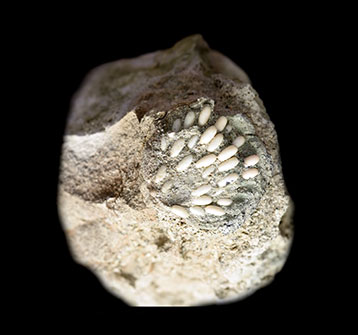Last updated: April 15, 2020
Lesson Plan
Some Parts Make Better Fossils than Others

- Grade Level:
- Upper Elementary: Third Grade through Fifth Grade
- Subject:
- Science
- Lesson Duration:
- 60 Minutes
- Additional Standards:
- 3rd Grade: 3-LS4-1, 3-LS4-2, and 3-LS4-3
- Thinking Skills:
- Applying: Apply an abstract idea in a concrete situation to solve a problem or relate it to a prior experience.
Essential Question
Is it possible to know all the details of ancient animals and plants?
Objective
Recognize that because some plants’ and animals’ parts fossilize better than others this creates missing information in the fossil record.
Background
Teachers should read and review information in A Fossil’s Journey with students.
Teachers should print off the Horse Skeleton Illustration.
Teachers should print off the Stegosaurus Skeleton Illustration.
Preparation
Materials
Horse skeleton diagram
Stegosaurus skeleton diagram
Drawing/coloring utensils
Set up
Ask students to name all the facts they know about horses. Then, list them on a white board or have students work in small groups and share their answers to the class.
Procedure
Step One: As a class, list facts about a horse. Facts might include large size, fast runner, eats grass, has grinding teeth, has long hair for a mane and tail, whinnies, is intelligent, is sociable with other horses, makes a good pet. Now imagine that the horse went extinct many years ago and all we have now are the fossilized bones of horses.
Step Two: Present the horse skeleton diagram to the class. Go through your list and ask the class which details we would still be able to discern from the skeleton alone. We would know that it was a large animal and could probably make some good guesses about its weight. We would know that it had grinding teeth and could probably guess from that that it ate some sort of tough vegetation like grass. The hooves would not be preserved but the shape of the foot bones would be a good indicator that it had hooves. The skeleton would also be useful to tell us that it was a fast runner. No details of the hair or skin would be known. Anything about social behavior or vocalization would also have to be guesses.
Step Three: Next present the Stegosaurus skeleton and interpret it the same way. Pass out a copy of the Stegosaurus skeleton to each student and have them put muscles and skin on the diagram. Remember hair, scales, and skin colors are largely the choice of the artist since fossil bones are not an indicator for such things
Step Four: As a class, discuss the following question together: Can paleontologists know everything for certain about a fossil animal?
Step Five: Complete How Living Things Become Fossils Lesson Plan.
Step Six: Complete Making a Trace Fossil Lesson Plan.
Step Seven: Complete the Post-Unit Questions found on A Fossil's Journey.
Vocabulary
Clastic Sediments: sediments result from the breakdown, through weathering, of pre-existing rocks.
Curator: a museum scientist.
Diagenesis: everything that happens to sediment after it is deposited. A potential fossil may be dissolved in the process of diagenesis, and other times it may become mineralized.
Fossil: any naturally occurring evidence of past life. Fossils need not be mineralized or enclosed in rock.
Organic sediments: pieces of tissues of plants or animals such as leaf litter on a forest floor.
Paleontologists: scientists who study fossils to understand the history of life on Earth.
Preparation: when paleontologist clean dirt and surrounding rocks off the fossil, glue it together (if broken) and store it.
Prospecting: to search the ground for fossils.
Metamorphic rocks: rocks changed by heat and pressure.
Mineralization or Petrification: the condition when a fossil has effectively turned to stone.
Trace Fossil: an impression of the animal or plant after its death such as a natural mold of a shell.
Sedimentary Structures: non-biological processes preserved in rocks like ancient ripple marks, mud cracks, or raindrops preserved in rock. They do not represent activities of living things, and they are not trace fossils.
Related Lessons or Education Materials
Denali National Park: Trace Fossils Webpage
Dinosaur National Monument: Trace Fossils Webpage
Contact Information
Email us about this lesson plan
